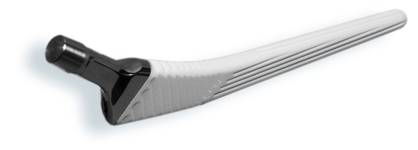
Plasma Sprayed HA Coatings
Technology
DOT applies the plasma sprayed HA coating to the implants in a vacuum chamber using the VPS vacuum technique.
Plasma-sprayed-HA-coatings - PDF: 600 KB
Range of Application
- Joint implants: hip joint, knee joint, ankle joint, shoulder joint, wrist joint, finger implants and spinal implants

Advantages of the Procedure
- Surface enlargement
- High primary stability of the implant due to rough surface
- Long-time stability due to bone ingrowth into the porous HA layer
- Improved fatigue strength of the implants compared with sintering techniques
- Application of VPS technique leads to increased purity and adhesive strength in comparison to other methods (e.g. APS - Atmospheric Plasma Spray)
Properties
*2 Mass ratio of the foreign phases relative to the mass ratio of the crystalline HA
- Color: light gray/white
- Coating thickness: 20–200 µm
- Roughness Ra: 5–13 µm
- Porosity: 10–20 %
- Adhesion strength: ≥ 15 MPa
- Ca/P ratio: 1.61–1.76
- Porous, crystalline surface
- Degree of HA crystalline phase: ≥ 45 %
- Very good biocompatibility
- Phase composition:
- HA ≥ 50 w% *1
- a-TCP, ß-TCP, TTCP ≤ 30 w% *2
- CaO ≤ 5 w% *2
*2 Mass ratio of the foreign phases relative to the mass ratio of the crystalline HA
SEM pictures of the HA sprayed surface

BONIT®
BONIT® is an electrochemical coating technique developed by DOT that is used to apply of a thin, ... Read more>>

